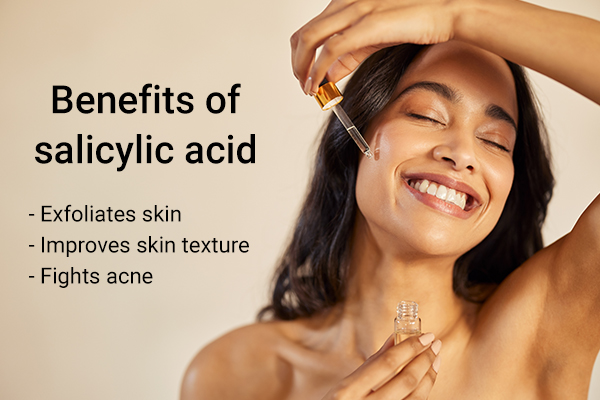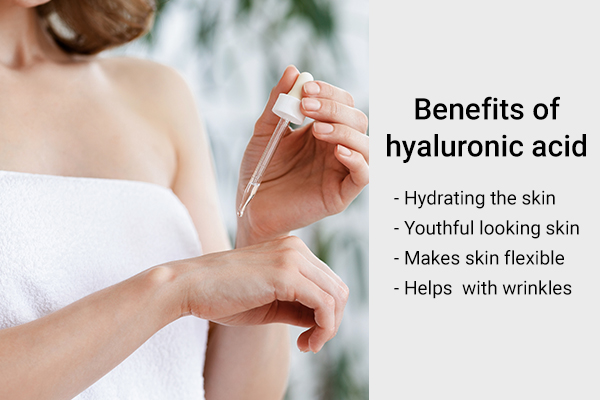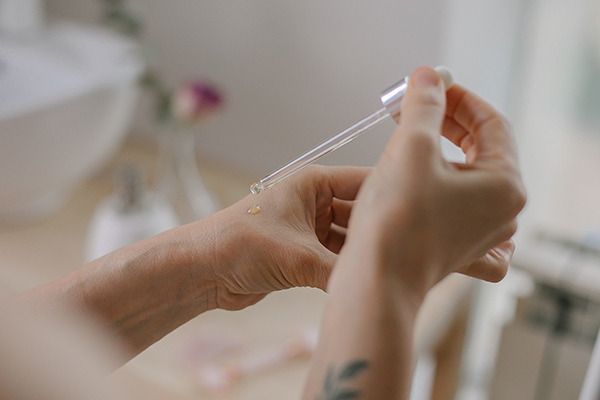In this article:
It is understandable if you spend a lot of your time troubling yourself about your skin health.

Even when you choose to conform to a skin care ritual, it can be difficult to figure out what to incorporate into your daily regimen based on your skin type. It is very easy to be bewildered by the countless options of skin care products available now.
If you are battling oily skin and desire to learn about the products you need to fight excessive oil production in the skin, having the right knowledge is important. Excessive oil in the skin can clog your pores and cause issues such as blackheads, acne, and pimples. (1)
Hyaluronic acid and salicylic are very prominent and widely used ingredients in cosmetics. However, even though both are good for tackling oily skin problems, salicylic acid might just be a bit better than hyaluronic acid for it.
Keep reading on to learn about the uses, pros, and cons of both salicylic and hyaluronic acid.
Hyaluronic Acid Versus Salicylic Acid for the Skin
| Hyaluronic acid | Salicylic acid |
|---|---|
| Hyaluronic acid is known for enhancing skin hydration, flexibility, and elasticity. | Salicylic acid exfoliates the skin and gets rid of dead skin cells. |
| Hyaluronic acid facilitates collagen production. | Salicylic acid improves skin texture. |
| Hyaluronic acid is helpful in the reduction of wrinkles and fine lines over time. | Salicylic acid can be used to treat acne. |
| Adverse effects with hyaluronic acid are not normally seen. | Salicylic acid has more potential side effects. |
Hyaluronic Acid Versus Salicylic Acid: Which Is Better for Oily Skin?
Using skin care products that contain salicylic acid and hyaluronic acid can benefit oily skin. (2)(3) However, salicylic acid just might be a better choice.
Hyaluronic acid is great for all skin types including oily skin. It helps keep the skin hydrated, soft, supple, and radiant by attracting and retaining moisture.
Plus, hyaluronic acid has been demonstrated by research to satisfactorily diminish sebum secretion in oily skin. It reduces the size of the sebaceous glands, making it a promising agent in dealing with increased sebum production. (3)
But for acne-prone oily skin, salicylic acid, a beta-hydroxy acid, might be better. It is known for its anti-inflammatory properties, ability to reduce excess sebum production, and action of shriveling up pimples, making it effective for oily and combination skin. (2)
Skin care experts also add that by reducing the size of sebaceous glands, salicylic acid effectively controls sebum production in oily skin. Moreover, salicylic acid is oil soluble and can penetrate the skin’s surface to unclog pores, eliminate excess sebum, and reduce oiliness.
So, considering these points, if you have to choose between hyaluronic acid and salicylic acid for oily skin, salicylic acid may be the preferred option.
Note: Use salicylic acid cautiously on sensitive skin as it can be very drying or irritating. In some cases, it may lead to hyperpigmentation.
Benefits of Salicylic Acid

The use of salicylic acid can offer these skin benefits.
1. Exfoliates skin
Salicylic acid exfoliates the skin and gets rid of dead skin cells by reducing the cementing substance between cells, loosening them, and finally facilitating their removal. (4)
2. Improves skin texture
Salicylic acid is also praised for its role in improving skin texture as it makes your skin smooth. It helps in refining the skin pores. (5)(6)
3. Fights acne
Acne vulgaris is either mild or moderate in most cases, and salicylic acid has been deemed well suited for the treatment of acne in 0.5% and 2% solutions. It is, in fact, superior to benzoyl peroxide in decreasing the number of acne lesions. (7)
Benefits of Hyaluronic Acid

The use of hyaluronic acid can offer these skin benefits.
1. Hydrates the skin
The most well-known use of hyaluronic acid is for skin hydration as it has the power to contain moisture. Keeping the skin hydrated is very crucial because, when the skin is not hydrated sufficiently, it cracks, compromising the skin barrier and making the skin prone to damage.
For proper skin hydration, using products that contain hyaluronic acid is an excellent option. (8)
2. Makes the skin youthful looking
Hyaluronic acid is pivotal for youthful-looking skin. It can hold 1,000 times its weight in water. It plumps up the skin and thus decreases the impression of fine lines.
Moreover, it safeguards the skin from free radicals, which induce cell damage and premature aging. (8)
3. Increases skin flexibility
Hyaluronic acid is known for enhancing skin flexibility and elasticity. Thus, it decreases the impression of wrinkles and fine lines. (9)
4. Reduces wrinkles
Hyaluronic acid facilitates collagen production, which is critical for providing the skin its structural strength. Hence, the skin can maintain its firmness and can evade wrinkles and fine lines. (10)
Is It Safe to Use Both Salicylic Acid and Hyaluronic Acid Together?
If you’re trying to find the right combination of skin care products for your oily skin care routine, consider using hyaluronic acid and salicylic acid together. Integrating both these products into your routine is good for skin health.
However, even though salicylic acid is terrific at penetrating your pores and expelling the buildup of dead skin and extra oil, it can be slightly drying, which is why it is good to use hyaluronic acid with salicylic acid.
Hyaluronic acid can draw water into your skin and keep it hydrated. It may also help lessen any irritation that is, sometimes, induced by salicylic acid.
How to Use Both Hyaluronic Acid and Salicylic Acid in Your Skin Care Routine?

The correct method of employing skin care products is to apply the one with the thinnest consistency first and apply the ones with a thicker consistency next. If you layer the products in this manner, you will get a favorable result.
Skin care experts highly advise the use of a moisturizer after putting on any salicylic acid-containing product. In short, always start with your toners and serums and then proceed to thicker formulations such as creams.
What Are Some Side Effects of Salicylic Acid?
Salicylic acid can have generally mild and temporary side effects. These include erythema and dryness, which can be managed by the regular use of topical moisturizers. (11)
What Are Some Side Effects of Hyaluronic Acid?
One study revealed no prominent statistically substantial side effects of hyaluronic acid such as stinging and itching immediately after product application or at any period during a 6-week use. Adverse effects with hyaluronic acid are not normally observed. (12)
Why Do Skin Care Products Not Improve Your Oily Skin?

Oily skin that does not show improvement after using the suitable products can be an outcome of an underlying health problem or some harmful habits that you might want to examine and change.
For example, a diet lacking in nutrients, insufficient water intake, or high stress levels could be the reason for your oily skin difficulties. A dermatologist can find the real problem and advise treatment options for dealing with your skin concerns.
Most-Asked Questions
How often should I use salicylic acid?
The frequency of using salicylic acid depends firmly on your skin type and skin issues. Salicylic acid is generally safe for use once or twice a day, as long as it is used as directed.
Who should not use salicylic acid?
Salicylic acid should not be employed on skin that is damaged, irritated, or infected.
What concentration of salicylic acid is safe to use?
Use products with a 1%–2% concentration of salicylic acid.
Can I use hyaluronic acid in combination with salicylic acid on my oily skin?
Yes, you can use hyaluronic acid with salicylic acid on oily skin. However, it’s important to start with lower concentrations and to patch test to ensure your skin tolerates the combination well.
Final Word
Oily skin can be problematic for some people as it can cause numerous skin issues such as acne.
Salicylic acid is thought to be great for managing oily skin and related issues as it reduces excessive sebum production. It’s often used with hyaluronic acid, which keeps the skin moisturized and hydrated without making it greasy.
This combination can work very nicely for oily skin. However, you may need to seek the guidance of your dermatologist to know how to use them and how often.
- Was this article helpful?
- YES, THANKS!NOT REALLY


